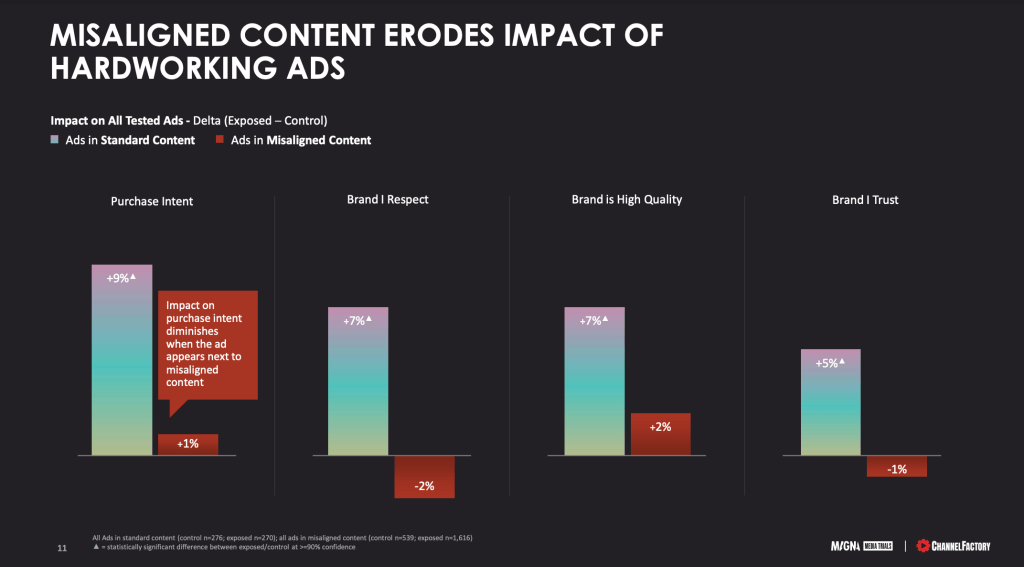By Brad Adgate, Published by Forbes
In a polarizing political environment, news programming across numerous platforms continues to generate millions of viewers each day. In a political off-year, three 24-hour news networks remain the three highest rated cable networks on television. Nonetheless, at times, polarizing comments or questionable content from news providers has led marketers, concerned about brand safety, to pull their ads. Conversely, reliable news providers continue to be a safe harbor for advertisers with positive results.
A study from MAGNA Media Trials and Disney Advertising Sales released today called “No News Is Bad News: Ads in News & Other Types of Content,” finds advertising in a reliable news source creates stronger brand effectiveness. The study also found a tailored ad in the news genre can deliver an optimal ROI for marketers. Below are some other findings.
People found news content to be more valuable, trustworthy and interesting. Respondents said ads in news content were 8% more relevant, 6% more valuable and 4% more trustworthy when compared to non-news programming.
News that is considered to be depressing can still help to drive brand impact. The study found brand favorability grew by 7% with product recommendations increased by 5% from ads airing in a gloomy newscast.
The survey also highlighted the importance of credibility of news sources, especially with upscale audiences. A total of 57% of respondents said marketers should vet news sources before advertising. For upper income households ($100K+), 61% agreed with the importance of sources, compared to 52% for households with an income of $35K or less.
Ads on a trusted, well-respected and high-quality news source, help advertisers to bolster such lower funnel attributes as brand favorability (+21%), research intent (+25%) and purchase intent (+21%).
Respondents said ad messaging should vary depending on the type of news. For example, with “hard news” a more focused message will increase brand favorability by 10%, purchase intent by 7% and research intent by 5%. In contrast, race and culture news requires marketers to take a “storytelling” message which would increase favorability by 11% and purchase intent by 10%.
The survey concludes with the following implications:
- Brands should support quality journalism, recognizing there is a difference between unsafe content and news on trusted websites.
- Advertisers should identify and deliver media against reliable news sources to drive better effectiveness. The reliability of the source has more of an impact on ad effectiveness than the news content itself.
- Optimize ad strategies that over index on your marketing goals, as the same ad performs differently across news genres
The survey was released at a time when social media has come under fire and government investigations for failing to restrict false news and misinformation. According to a recent Pew Research survey, 48% of U.S. adults get their news from social media “often” or “sometimes.”
Andrew Heyward, professor at ASU’s Walter Cronkite School of Journalism & Mass Communication and former President of CBS News says, ”This study is encouraging for both marketers and news organizations — and therefore for consumers. Marketers who advertise in news outlets benefit from a ‘halo effect’ that relies more on the credibility of the news source than the specific nature of the content, which means that high-quality, trustworthy, responsible news coverage is not just important for our democracy, but also good for the bottom line.”
In a statement about the survey, Joshua Lowcock, the Chief Digital Officer at UM Worldwide and Global Safety Officer at IPG Mediabrands says, “An important insight from the study is how passionate people feel about the news source that a brand advertises on, and the reliability of that source is a key driver of purchase intent.” Lowcock continues, “Brands should support quality journalism if they want to maximize the effectiveness of their ad spend. It recognizes that credible and trusted news websites are not a brand safety risk and that where you place your ad matters.”
Asaf Davidov, VP Measurement & Insights at Disney Advertising Sales, added, “The diversified storytelling that news provides —from local community coverage, to pop culture, to international affairs— is where the opportunity lies. These insights confirm that consumers associate ads seen in news with being trustworthy and valuable. Which offers brands the opportunity to tailor their message to the audience.”
A similar study with comparable results, was directed by media research leader Bill Harvey. Among the findings, Harvey notes, “In the largest multivariate study in history ($2.2 trillion in sales vs. $48 billion in ad spend), we found news and sports – the two main forms of live TV – have the highest return on ad spend (ROAS) of all linear television and digital genres, other than network TV digital which is even higher. A literature review suggests the main reason for the advertising impact of news is cognitive, that it is the media type eliciting the highest degree of focused watching and listening attention.”
With fundraising for the 2022 midterm elections soaring, it is projected there will be record year for political ad dollars rivalling the 2020 elections. Local broadcast news, especially in battleground states, is expected to be a primary beneficiary of the bounty with candidates expected to invest billions of ad dollars in messaging. The MAGNA/Disney survey found for political (and hard) news sources reliability is an important criterion.
The MAGNA/Disney study recruited participants from a nationally representative panel, where they were randomized to a brand’s ad or a control ad. Participants watched a video or viewed an article of their choice on their assigned platform. Appropriate ads were served based on test or control groups. A post-exposure survey was conducted to measure impact on traditional branding metrics and to obtain qualitative feedback. The variables tested were across content genres, news genres, platforms, ad formats, brand verticals and creative strategies.
Read the article in Forbes
